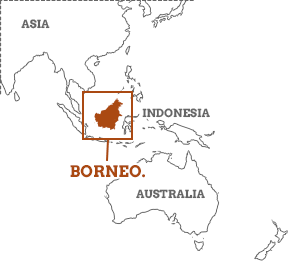Volunteering in Borneo guide
Read just a handful of the reviews on our Borneo volunteer vacations and you’ll quickly grasp what they’re all about: life affirming, intensely rewarding, and very memorable. But with this guide we aim to get into the real nitty-gritty of these trips, why they’re so vital, what they actually involve on a day-to-day basis, and how the wildlife of Borneo is going to benefit from your efforts.


Vacations are always better when they have a purpose to them, and with its incredible but threatened wildlife, Borneo has purpose to spare. ![]()

Not everyone is content to spend their vacations with a paperback on the beach, or learning about the world through museums and galleries. If you want to give back in a real sense, then in Borneo your time and labour can make a tangible difference to beautiful but endangered creatures including orangutans, sun bears and green sea turtles.
Find out more in our volunteering in Borneo guide.
What does volunteering in Borneo entail?
Practicalities
Borneo volunteering vacations typically range in length from one to four weeks, during which time you may be accommodated in shared jungle lodges at a wildlife center, or even with local Iban or Dayak tribes, sharing meals and bedding down in their traditional longhouse, depending on the project you’re involved in.
You may be working either in Malaysian or Indonesian Borneo (Kalimantan). Malaysian Borneo, comprising the states of Sarawak and Sabah, covers most of the island’s north, and has two prestigious orangutan rehabilitation centers: Matang, just outside Sarawak’s capital, Kuching, and Sepilok in the far northeast of Sabah. Volunteering in Kalimantan spans Tanjung Puting National Park; Samboja Lestari, a tranche of restored rainforest near the city of Balikipapan, and the renowned Nyaru Menteng Orangutan Sanctuary with some 400 residents, and a superb rehabilitation and reintroduction programme.
Some trips involve a lot more actual volunteer work than others. There are itineraries that resemble standard wildlife watching tours, with a day or so helping out at an orangutan rehabilitation center for instance, perhaps with enrichment tasks, between jungle treks and handicrafts lessons. Other itineraries are much more conservation focused and can mean six-day weeks of physical labour such as helping to build enclosures, in hot and humid conditions.
Trips can either be small group tours, following a fixed itinerary on set dates, or tailormade giving you greater flexibility on when you travel. In both cases you will be working alongside a group of other volunteers as well as full time project staff, so this is fantastic for getting to know like-minded people, and also a great way to make valuable connections if you’re interested in pursuing conservation as a career.
Orangutan sanctuary volunteering in Borneo
Care for stunning endangered orangutans in beautiful Borneo
From
£1195 to £1895
13 days
ex flights
Borneo Wildlife Volunteer Project
Encounter orangutans and elephants in the Bornean jungle.
From
£1295
12 days
ex flights
Orangutan volunteering in Borneo
Volunteer at an award-winning orangutan rehabilitation center in Malaysian Borneo
From
£795 to £1995
8 days
ex flights
Borneo family volunteering vacation
Encounter orangutans and meet local tribes in magical Borneo
From
£845
7 days
ex flights
Orangutan conservation in East Kalimantan, Indonesia
Work with orangutans & sun bears
From
£1395 to £2195
13 days
ex flights
Wildlife conservation in Borneo
Conserve orangutans and elephants in Borneo's rainforests
From
US $1200
7 days
ex flights
Travel Team
If you'd like to chat about Borneo volunteering or need help finding a vacation to suit you we're very happy to help.
1-866-821-6866
Call toll free
Calling from outside the USA
How fit do I need to be?
You don’t need any prior experience to volunteer in Borneo, all that’s required is to be in reasonable physical condition, and of course enthusiastic about conservation. If you do have any particular skills however, such as carpentry, it’s worth letting the operator know beforehand in case there is a project you would be particularly well suited for.It’s important to be aware that for their safety and your own it’s very unlikely that you will have any actual physical contact with the animals. Orangutans for instance may look cuddly, but they’re incredibly strong. There is also the risk that humans can unwittingly pass on diseases or viruses that could potentially be fatal to the animals.
What you’ll be doing
Depending on the nature of your trip, where you’re based and the precise needs on the ground at the time of your visit, you might be helping out with a wide range of conservation related tasks:






















